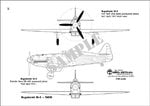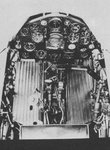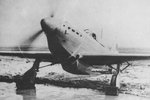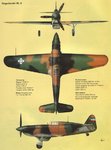Milos Sijacki
Senior Airman
The Rogožarski IK-3, a low wing monoplane single seat interceptor fighter with retractable landing gear, was a product of the design team of Ljubomir Ilić and Kosta Sivčev as a follow on to their IK-1/IK-2 fighter. Joined by Ing. Zrnić, they initiated the design in 1936 under strict secrecy, wind tunnel testing was done in France, before submitting the design to the Yugoslav Air Ministry. Construction of the IK-3 was assigned to Rogožarski A. D. in Belgrade and the prototype flew for the first time in the spring of 1938.
Artist vision of encouter between IK-3 and Me
Artist vision of encouter between IK-3 and Me
The IK-3 was powered by a Hispano-Suiza 12Y-29 liquid-cooled inline engine that was rated at 890 hp for take-off and at 920 hp at 11,810 feet altitude. The prototype was armed with one 20 mm Hispano-Suiza HS-404 cannon and two 7.92 mm FN-Browning machine guns mounted over the engine in the fuselage. The aircraft was of mixed steel tube, wood, and fabric construction with the retractable landing gear of Messier design. Its construction was similar to Hawker Hurricane.
Pilots of 51st fighter group in Zemun airport 1940,behind pilots is IK3 fighter.
Pilots of 51st fighter group in Zemun airport 1940,behind pilots is IK3 fighter.
Six test pilots flew the prototype in a very successful test program before it was lost. On January 19, 1939 the test pilot, Captain Pokorni, after a series of acrobatic maneuvers entered a terminal velocity dive from which he did not recover. After an investigation the aircraft was found not at fault and the Air Ministry ordered an initial lot of twelve aircraft.
The production IK-3 was refined with a number of changes including modifications to the sliding cockpit canopy, addition of a bullet proof windshield, and installation of the Avia H.S. 12Ycrs inline engine, a Czech built version of the Hispano-Suiza installed in the prototype. The first IK-3s were delivered in the summer of 1940 to an experimental fighter squadron whose pilots preferred it to the Messerschmitt Bf 109E-3 and the Hawker Hurricane, as the IK-3 was more maneuverable and could make tighter turns. Additionally, the aircraft was found to be very maintainable.
With the success of the IK-3, planning began for licensing manufacture in Turkey as well as increased production by Rogožarski. But before the second lot of IK-3 could be started German forces invaded Yugoslavia.
As production of the IK-3 proceeded the design team was working on improved versions of the IK-3 and other designs. Among the IK-3 improvements in work was installation of a more powerful engine. Engines that were considered to various extents were an upgraded 1,100 hp Hispano-Suiza 12Y-51, the Daimler-Benz DB-601A, and the 1,030 HP Rolls-Royce Merlin III engines. Also, Rogožarski was pursuing a new fighter design, the IK-5, that was to be powered by two Hispano-Suiza 12Y engines. Two versions of the design were planned, a single seat interceptor and a two seat long range "destroyer" with heavy nose mounted armament. Models of the IK-5 had been tested in wind tunnels and construction of a prototype begun when the German invasion ended this and all other efforts.
At the beginning of the April war, only 6 out of 12 IK-3 from the first production series were operational. One aircraft was lost in an air accident before the war, four were in workshop on scheduled services and repairs and one aircraft was undergoing modification to Series II IK-3 standard in Rogozarski airplane factory. Six remaining IK-3s were allocated to 161st and 162nd fighter squadron (3 IK-3 each) of the 51st Fighter group. 51st fighter group was part of the 6th fighter regiment of Royal Yugoslav Air Force which was tasked to defend Yugoslav capital, Belgrade. Both fighter squadrons were stationed at Zemun airport.
Operators
* Kingdom of Yugoslavia
General characteristics
* Crew: one, pilot
* Length: 27 ft 5 in (8.38 m)
* Wingspan: 33 ft 10 in (10.33 m)
* Height: 10 ft 8 in (3.23 m)
* Wing area: 179 ft² (16.6 m²)
* Empty: 4,123 lb (1874 kg)
* Loaded: 5,291 lb (2405 kg)
* Maximum takeoff: lb (kg)
* Powerplant: 1× Avia-built Hispano-Suiza 12Ycrs twelve cylinder Vee liquid-cooled engine, 920 shp (686 kW) each
Performance
* Maximum speed: 327 mph at 17,715 ft (526 km/h at 5401 m)
* Range: 310 miles (496 km)
* Service ceiling: 26,250 ft (8,003 m)
* Rate of climb: ft/min (m/min)
* Wing loading: 29 lb/ft² (113 kg/m²)
* Power/mass: 0.17 hp/lb (0.29 kW/kg)
Armament
* 1× 20 mm Hispano-Suiza HS-404 cannon
* 2× 7.92 mm FN-Browning machine guns
Artist vision of encouter between IK-3 and Me
Artist vision of encouter between IK-3 and Me
The IK-3 was powered by a Hispano-Suiza 12Y-29 liquid-cooled inline engine that was rated at 890 hp for take-off and at 920 hp at 11,810 feet altitude. The prototype was armed with one 20 mm Hispano-Suiza HS-404 cannon and two 7.92 mm FN-Browning machine guns mounted over the engine in the fuselage. The aircraft was of mixed steel tube, wood, and fabric construction with the retractable landing gear of Messier design. Its construction was similar to Hawker Hurricane.
Pilots of 51st fighter group in Zemun airport 1940,behind pilots is IK3 fighter.
Pilots of 51st fighter group in Zemun airport 1940,behind pilots is IK3 fighter.
Six test pilots flew the prototype in a very successful test program before it was lost. On January 19, 1939 the test pilot, Captain Pokorni, after a series of acrobatic maneuvers entered a terminal velocity dive from which he did not recover. After an investigation the aircraft was found not at fault and the Air Ministry ordered an initial lot of twelve aircraft.
The production IK-3 was refined with a number of changes including modifications to the sliding cockpit canopy, addition of a bullet proof windshield, and installation of the Avia H.S. 12Ycrs inline engine, a Czech built version of the Hispano-Suiza installed in the prototype. The first IK-3s were delivered in the summer of 1940 to an experimental fighter squadron whose pilots preferred it to the Messerschmitt Bf 109E-3 and the Hawker Hurricane, as the IK-3 was more maneuverable and could make tighter turns. Additionally, the aircraft was found to be very maintainable.
With the success of the IK-3, planning began for licensing manufacture in Turkey as well as increased production by Rogožarski. But before the second lot of IK-3 could be started German forces invaded Yugoslavia.
As production of the IK-3 proceeded the design team was working on improved versions of the IK-3 and other designs. Among the IK-3 improvements in work was installation of a more powerful engine. Engines that were considered to various extents were an upgraded 1,100 hp Hispano-Suiza 12Y-51, the Daimler-Benz DB-601A, and the 1,030 HP Rolls-Royce Merlin III engines. Also, Rogožarski was pursuing a new fighter design, the IK-5, that was to be powered by two Hispano-Suiza 12Y engines. Two versions of the design were planned, a single seat interceptor and a two seat long range "destroyer" with heavy nose mounted armament. Models of the IK-5 had been tested in wind tunnels and construction of a prototype begun when the German invasion ended this and all other efforts.
At the beginning of the April war, only 6 out of 12 IK-3 from the first production series were operational. One aircraft was lost in an air accident before the war, four were in workshop on scheduled services and repairs and one aircraft was undergoing modification to Series II IK-3 standard in Rogozarski airplane factory. Six remaining IK-3s were allocated to 161st and 162nd fighter squadron (3 IK-3 each) of the 51st Fighter group. 51st fighter group was part of the 6th fighter regiment of Royal Yugoslav Air Force which was tasked to defend Yugoslav capital, Belgrade. Both fighter squadrons were stationed at Zemun airport.
Operators
* Kingdom of Yugoslavia
General characteristics
* Crew: one, pilot
* Length: 27 ft 5 in (8.38 m)
* Wingspan: 33 ft 10 in (10.33 m)
* Height: 10 ft 8 in (3.23 m)
* Wing area: 179 ft² (16.6 m²)
* Empty: 4,123 lb (1874 kg)
* Loaded: 5,291 lb (2405 kg)
* Maximum takeoff: lb (kg)
* Powerplant: 1× Avia-built Hispano-Suiza 12Ycrs twelve cylinder Vee liquid-cooled engine, 920 shp (686 kW) each
Performance
* Maximum speed: 327 mph at 17,715 ft (526 km/h at 5401 m)
* Range: 310 miles (496 km)
* Service ceiling: 26,250 ft (8,003 m)
* Rate of climb: ft/min (m/min)
* Wing loading: 29 lb/ft² (113 kg/m²)
* Power/mass: 0.17 hp/lb (0.29 kW/kg)
Armament
* 1× 20 mm Hispano-Suiza HS-404 cannon
* 2× 7.92 mm FN-Browning machine guns










